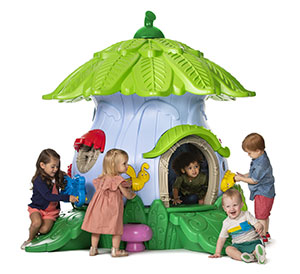How Many Days and Hours of School Time Each US State Requires by Grade – Including Time Spent on Playground Equipment
Time never seems to move more slowly than when watching the clock count down to the end of another day of school or to recess time when you can go out and play on the school playground equipment. How many hours is a whole school day? In America, that depends on each state’s required instructional time policies. For example, the national average high school day length is 6 hours and 38.4 minutes, while Texas averages 7 hours and Washington averages just more than 6 hours. The team at PlaygroundEquipment.com has created a chart to visualize required instructional time by state as a reference for parents, caregivers, educators, and students themselves. Keep in mind that this includes both time spent learning and time spent on the school playground equipment. Here are the required school days by state and the required school hours by state:
Click to view the full-size infographic:
Embed this image on your site:
How Many Days Is a School Year?
The average days in the school year in the United States will vary by state, but the majority of states (29 to be exact) require 180 school days.
What State Has the Most Days of School?
According to the data provided by the National Center for Education Statistics, Illinois and North Carolina top the chart at 185 required school days.
What State Has the Fewest Required School Days?
Besides the states that do not have a required minimum number of school days each year, Colorado has the fewest required school days in the United States, at 160. States with no minimum school day requirements are Arkansas, Idaho, Nebraska, New Mexico, Ohio, Oregon, South Dakota, and Wisconsin.
What States Have Four-Day School Weeks?
Several states have introduced four-day school weeks, including Colorado, New Mexico, Idaho, Oklahoma, and Oregon. 60 percent of Colorado’s districts and around 40 percent of New Mexico and Oregon’s districts have implemented a four-day school week. These schedules most often get rid of classes on Fridays, and they usually add around an hour per day when school is in session. Four-day school week schedules achieve an average of around 148 school days per year, which is 32 days fewer than the national average of 180 school days.
Does Recess Count as Instructional Time? Time Spent Playing on the Swingset at School may also be Time Spent Learning
This depends on the state. We examined each state’s recess and instructional time policies to determine which states allow recess to be counted toward instructional time, and these include Arkansas, Colorado, Florida, Georgia, Illinois, Kansas, Kentucky, Michigan, Nebraska, Nevada, New Hampshire, New Mexico, North Carolina, North Dakota, Oregon, Rhode Island, South Dakota, Tennessee, Texas, Utah, Wisconsin, and Wyoming. How much recess can be applied toward required instructional time varies by state, but it is definitely a step in the right direction! Many educators acknowledge that effective learning can happen outside of the classroom and one the playground swings; let’s not discount the learning that active play fosters.
Does Recess Take Away From Learning Time? – Merry-go-Rounds are a Great Way for Students to Get Active
Many experts believe that recess can be profoundly beneficial for a student’s academic performance, behavior, life skills, and more; kids need an outlet for their energy throughout the school day and sometimes that means playing out on the merry-go-rounds. Check out our infographic on the benefits of recess to find out more. We also did an extensive analysis of recess policies across the United States — check out how your state compares.
Required Instruction Time by State
|
State |
School Days |
Instruction Hours |
|
Alabama |
180 |
1,080 |
|
Alaska |
180 |
K-3 = 740 Grades 4-12 = 900 |
|
Arizona |
180 |
Half-day kindergarten = 356 Grades 1-3 = 712 Grades 4-6 = 890 Grades 7-8 = 1,000 Grades 9-12 = 720 |
|
Arkansas |
178 |
No requirement |
|
California |
180 |
Kindergarten = 600 Grades 1-3 = 840 Grades 4-8 = 900 Grades 9-12 = 1,080 |
|
Colorado |
160 |
Half-day kindergarten = 435 Full-day kindergarten = 870 Grades 1-5 = 968 Grades 6-12 = 1,056 |
|
Connecticut |
180 |
Half-day kindergarten = 450 Full-day kindergarten = 900 Grades 1-12 = 900 |
|
Delaware |
No requirement |
K-11 = 1,060 Grade 12 = 1,032 |
|
Florida |
180 |
K-3 = 720 Grades 4-12 = 900 |
|
Georgia |
180 |
No requirement |
|
Hawaii |
180 |
1,080 |
|
Idaho |
District option |
Kindergarten = 450 Grades 1-3 = 810 Grades 4-8 = 900 Grades 9-12 = 990 |
|
Illinois |
180 |
No requirement |
|
Indiana |
180 |
No requirement |
|
Iowa |
180 |
1,080 |
|
Kansas |
Kindergarten-11 = 186 Grade 12 = 181 |
Kindergarten = 465 Grades 1-11 = 1,116 Grade 12 = 1,086 |
|
Kentucky |
170 |
1,062 |
|
Louisiana |
177 |
1,062 |
|
Maine |
175 |
No requirement |
|
Maryland |
180 |
Elementary and middle/junior high schools = 1,080 Public high schools = 1,170 |
|
Massachusetts |
180 |
Kindergarten = 425 Grades 1-5 = 900 Grades 6-12 = 990 |
|
Michigan |
180 |
1,098 |
|
Minnesota |
165 |
Half-day kindergarten = 425 Full-day kindergarten = 850 Grades 1-6 = 935 Grades 7-12 = 1,020 |
|
Mississippi |
180 |
No requirement |
|
Missouri |
5-day week = 174 4-day week = 142 |
Kindergarten = 522 Grades 1-12 = 1,044 |
|
Nebraska |
No requirement |
Kindergarten = 400 Grades 1-8 = 1,032 Grades 9-12 = 1,080 |
|
Nevada |
180 |
No requirement |
|
New Hampshire |
180 |
Kindergarten = 450 Grades 1-5 = 945 Grades 6-12 = 990 |
|
New Jersey |
180 |
No requirement |
|
New Mexico |
No requirement |
Half-day kindergarten = 450 Full-day kindergarten = 990 Grades 1-6 = 990 Grades 7-12 = 1,080 |
|
New York |
180 |
No requirement |
|
North Carolina |
185 |
1,025 |
|
North Dakota |
175 |
K-8 = 952 Grades 9-12 = 1,038 |
|
Ohio |
District option |
Half-day kindergarten = 455 Full-day kindergarten = 910 Grades 1-6 = 910 Grades 7-12 = 1,001 |
|
Oklahoma |
180 |
1,080 |
|
Oregon |
No requirement |
Half-day kindergarten = 450 Full-day kindergarten = 900 Grades 1-8 = 900 Grades 9-11 = 990 Grade 12 = 966 |
|
Pennsylvania |
180 |
Kindergarten = 450 Grades 1-8 = 900 Grades 9-12 = 990 |
|
Rhode Island |
180 |
1,080 |
|
South Carolina |
180 |
No requirement |
|
South Dakota |
District option |
Kindergarten = 438 Grades 1-5 = 875 Grades 6-12 = 963 |
|
Tennessee |
180 |
No requirement |
|
Texas |
No requirement |
1,260 |
|
Utah |
180 |
Kindergarten = 450 Grade 1 = 810 Grades 2-12 = 990 |
|
Vermont |
175 |
No requirement |
|
Virginia |
180 |
Kindergarten = 540 Grades 1-12 = 990 |
|
Washington |
180 |
Kindergarten = 1,000 Grades 1-8 = 1,000 Grades 9-12 = 1,080 |
|
West Virginia |
180 |
No requirement |
|
Wisconsin
|
No requirement |
Kindergarten = 437 Grades 1-6 = 1,050 Grades 7-12 = 1,137 |
|
Wyoming |
175 |
Kindergarten = 450 Elementary = 900 Middle/junior high = 1,050 High school = 1,100 |
This article was last updated on October 16th, 2024 by author Kim Hart


